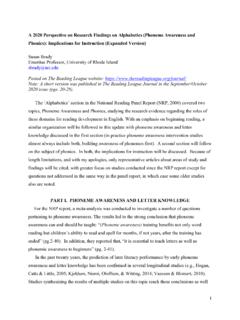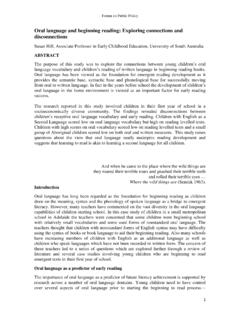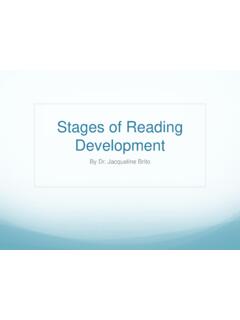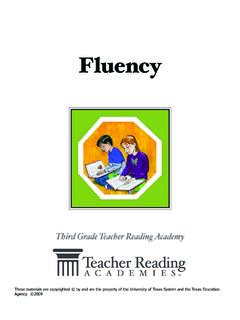Transcription of Curriculum Evaluation Tool August 2020 - TRL National
1 Curriculum Evaluation TOOL. This Curriculum Evaluation tool features components that align with the Simple View of reading (Gough & Tunmer, 1986) and Scarborough's Rope (Scarborough, 2001). Word Recognition and Language comprehension are broken down into subcomponents and writing and spelling as well as assessment are included. Green Flags indicate instructional practices that are aligned with the science of reading . Red Flags indicate instructional practices that are not aligned with the science of reading . If the Curriculum you are evaluating features a particular Red Flag, place an X in the adjacent red box. If many/most of the red boxes are checked for a particular component, it is likely that the program is not aligned with the Science of reading .
2 Keep searching! NOTES: This tool is to be considered a living document meaning that it will be periodically updated based on user feedback, suggestions for optimizing use, etc. We thank those who contributed to its content. K-2 August 2020 Copyright The reading League 2020. WORD RECOGNITION. Phonological and Phoneme Awareness Red Green Flags Red Flags flag present Instruction includes larger units of phonological awareness (syllable, Instruction only attends to larger units of phonological awareness rhyme, onset-rime) as well as the phoneme level. (syllables, rhyme, onset-rime) without moving to the phoneme level ( , blends such as tr' are kept intact rather than having students notice their individual sounds).
3 Instruction includes all phoneme awareness tasks including those that Phoneme awareness instruction does not include more advanced feature advanced manipulation (isolating, blending, segmenting, deletion, manipulation tasks. substitution, reversal). Advanced phoneme proficiency instruction is evident beyond K-1; Phoneme awareness instruction discontinues after K-1. students are both accurate and automatic with these skills. Phonemic awareness is taught directly, explicitly, and systematically. Phonemic awareness is taught implicitly and briefly. When phoneme awareness is taught, awareness of individual phonemes When phoneme awareness is taught, phonemes are immediately is established prior to introduction of corresponding graphemes.
4 Connected to graphemes (printed letters). All levels of phonological and phoneme awareness are assessed and Phonological and phoneme awareness are not assessed and monitored monitored regularly. regularly. GLOSSARY. Phonological awareness: One's sensitivity to, or explicit awareness of, the phonological structure of words in one's language. This is an umbrella . term that is used to refer to a student's sensitivity to any aspect of phonological structure in language. It encompasses awareness of individual words in sentences, syllables, and onset-rime segments, as well as awareness of individual phonemes. Phoneme awareness: The ability to notice, think about, or manipulate the individual phonemes (sounds) in words.
5 It is the ability to understand that sounds in spoken language work together to make words. This term is used to refer to the highest level of phonological awareness: awareness of individual phonemes in words. Phoneme: The smallest unit of sound within our language system. A phoneme combines with other phonemes to make words. Grapheme: A letter or letter combination that spells a phoneme; it can be one, two, three, or four letters in English ( , i, ou, igh, ough). NOTES: 1. Phonics Red Green Flags Red Flags flag present Letter-sound correspondences are taught in an explicit, systematic, and Letter-sound correspondences are taught opportunistically or implicitly sequential fashion, from simple to complex.
6 During text reading . Phonics instruction is robust with explicit instruction, cumulative review, Phonics instruction takes place in short mini-lessons.. and application in reading and writing. The initial instructional sequence includes a mixture of short vowels and The initial instructional sequence introduces a large number of (or all). consonants. consonants before a vowel is introduced, or vowels are all taught in rapid succession. Segmenting and blending are taught explicitly and practiced regularly, in Segmenting and blending are not explicitly taught nor practiced. both decoding and encoding. Explicit instruction directs students' attention to the structure of the Instruction encourages students to memorize whole words, guess at word; the emphasis is on phonic decoding.
7 Words in context, or use picture clues. Instruction includes letter sounds correspondences, syllable types, word Instruction in phonics ends once letter sounds correspondences are families, word analysis skills for multisyllabic words, and morphemes. taught. Irregular high-frequency words are taught by drawing attention to both Irregular high-frequency words are taught as whole-word units, often as regular and irregular sounds. stand-alone sight words to be memorized. Opportunities to practice decoding words in isolation are provided. No opportunities for word-level decoding practice are provided. Instruction includes recursive review of phonics/encoding skills. Instruction is typically one and done ; phonics/encoding skills are introduced but with very little or very short-term review.
8 Phonics skills are practiced by applying letter-sound knowledge in Early text is predominantly predictable, leveled texts which includes decodable texts that match the phonics elements taught, securing phonic phonic elements that have not been taught and encourages memorizing decoding. patterns and using picture clues rather than phonic decoding. GLOSSARY. Explicit: Explicit instruction involves direct explanation. The teacher's language is concise, specific, and related to the objective. Another characteristic of explicit instruction is a visible instructional approach which includes a high level of teacher/student interaction. Explicit instruction means that the actions of the teacher are clear, unambiguous, direct, and visible.
9 This makes it clear what the students are to do and learn. Nothing is left to guess work. Implicit: Implicit instruction does not provide direct or specific guidance on what is to be learned. Systematic: The material follows a sequence beginning with the easiest/basic elements preceding to the most difficult. Morpheme: The smallest meaningful unit of a word. Irregular high-frequency words: Words that BOTH highly frequent in text and not spelled phonetically ( , said, of, one). NOTES: 2. Fluency Red Green Flags Red Flags flag present Instruction includes teacher-led modeling, oral reading by students, and Instruction focuses primarily on student silent reading . immediate feedback.
10 reading accuracy and automaticity are emphasized. Rate is emphasized over accuracy; attention is given to students reading words quickly. Word-level fluency practice is provided. Word-level fluency practice is not provided. Fluency is viewed only as text- reading fluency. Fluency is practiced in a variety of texts (narrative, informational, poetry, Fluency is practiced only in narrative text or with repeated readings of lists, etc.). patterned text. Fluency is measured using a normed Oral reading Fluency assessment. Fluency assessment allows teachers acceptance of incorrectly decoded words if they are close in meaning to the target word. GLOSSARY. Automaticity: Performing a reading task without conscious effort.












